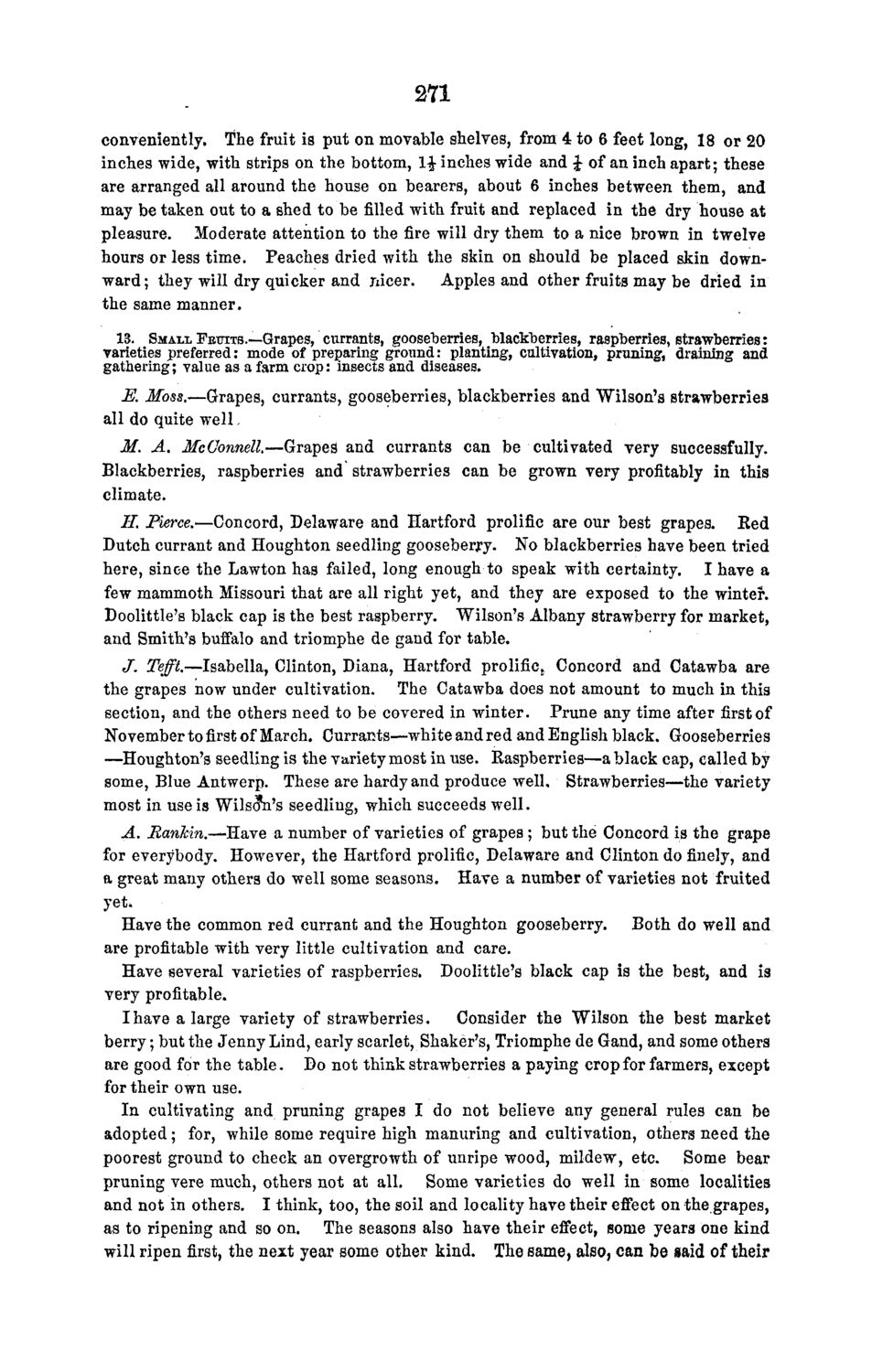| |
| |
Caption: Board of Trustees Minutes - 1868
This is a reduced-resolution page image for fast online browsing.

EXTRACTED TEXT FROM PAGE:
271 conveniently. The fruit is put on movable shelves, from 4 to 6 feet long, 18 or 20 inches wide, with strips on the bottom, 1£ inches wide and J- of an inch apart; these are arranged all around the house on bearers, about 6 inches between them, and may be taken out to a shed to be filled with fruit and replaced in the dry house at pleasure. Moderate attention to the fire will dry them to a nice brown in twelve hours or less time. Peaches dried with the skin on should be placed skin downward; they will dry quicker and nicer. Apples and other fruits may be dried in the same manner. 13. SMALL FETTITS.—Grapes, currants, gooseberries, blackberries, raspberries, strawberries: varieties preferred: mode of preparing ground: planting, cultivation, pruning, draining and gathering; value as a farm crop: insects and diseases. E. Moss.—Grapes, currants, gooseberries, blackberries and Wilson's strawberries all do quite well ' M. A. McGonnelL—Grapes and currants can be cultivated very successfully. Blackberries, raspberries and strawberries can be grown very profitably in this climate. H. Pierce.—Concord, Delaware and Hartford prolific are our best grapes. Eed Dutch currant and Houghton seedling gooseberry. No blackberries have been tried here, since the Lawton has failed, long enough to speak with certainty. I have a few mammoth Missouri that are all right yet, and they are exposed to the winter. Doolittle's black cap is the best raspberry. "Wilson's Albany strawberry for market, and Smith's buffalo and triomphe de gand for table. J. Tefft.—Isabella, Clinton, Diana, Hartford prolific^ Concord and Catawba are the grapes now under cultivation. The Catawba does not amount to much in this section, and the others need to be covered in winter. Prune any time after first of November to first of March. Currants—white and red and English black. Gooseberries —Houghton's seedling is the variety most in use. Raspberries—a black cap, called by some, Blue Antwerp. These are hardy and produce well. Strawberries—the variety most in use is Wilso*n's seedling, which succeeds well. A. Rankin.—Have a number of varieties of grapes; but the Concord is the grape for everybody. However, the Hartford prolific, Delaware and Clinton do finely, and a great many others do well some seasons. Have a number of varieties not fruited yet. Have the common red currant and the Houghton gooseberry. Both do well and are profitable with very little cultivation and care. Have several varieties of raspberries. Doolittle's black cap is the best, and is very profitable. I h a v e a l a r g e variety of strawberries. Consider the Wilson the best market berry; but the Jenny Lind, early scarlet, Shaker's, Triomphe de Gand, and some others are good for the table. Do not think strawberries a paying crop for farmers, except for their own use. In cultivating and pruning grapes I do not believe any general rules can be adopted; for, while some require high manuring and cultivation, others need the poorest ground to check an overgrowth of unripe wood, mildew, etc. Some bear pruning vere much, others not at all. Some varieties do well in some localities and not in others. I think, too, the soil and locality have their effect on the grapes, as to ripening and so on. The seasons also have their effect, some years one kind will ripen first, the next year some other kind. The same, also, can be said of their
| |